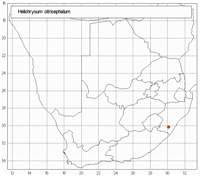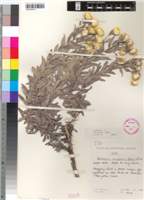Origin of name:
citrinus /-a/-um = lemon yellow coloured
cephalum = head
Diagnostic characters:
Large solitary headsLemon-yellow bractsDensely leafy
Description:
Shrub up to 1 m tall and as much across, main branches bare, rough with persistent leaf bases, flowering shoots grey-felted, glandular, very closely leafy. Leaves mostly 30�50 x 7�18 mm, oblong-lanceolate to elliptic-lanceolate, uppermost lanceolate, apex acute to acuminate, apiculate, base narrowed, rounded, sessile, both surfaces silvery-grey felted, glandular as well. Heads heterogamous, campanulate, c. 15 mm long, 25 mm across the radiating bracts, 4�20 solitary at the tips of long (50�120 mm) leafy peduncles corymbosely arranged. Involucral bracts in 6�12 series, graded, lanceolate, acute to very acute, much exceeding flowers, glossy, pale lemon-yellow. Receptacle honeycombed. Flowers 465�484, 16�19 female, 446�468 homogamous, yellow. Ovary 0.75 mm long, glabrous. Achenes not seen. Pappus bristles many, about equaling the corolla, tips barbellate, shaft smooth, bases not cohering.
Flowering in February.
Distribution:
Grows in coarse herbage, probably on forest margins. Ixopo area in KwaZulu-Natal.
Grassland Biome.
Notes:
Easily recognized by its shrubby habit, grey leaves and lemon-yellow heads, more like the tropical species H. petersii Oliv. & Hiern than any S. African species.
Known only from the type collection and one made by Krook in the same area nearly a hundred years ago. The only known locality at Ixopo has been destroyed by road-widening.
Taxonomy:
Literature:
Helichrysum citricephalum Hilliard & Burtt in Notes R. bot. Gdn Edinb. 34: 259 (1976); Hilliard, Compositae in Natal 249 (1977).
Type:
KwaZulu-Natal, Ixopo distr., Ixopo to Umzimkulu road, straggling shrub in forest margin type vegetation on steep bank at roadside, 26 ii 75, Hilliard & Burtt 8045 (NU, holo.; E; K; MO; PRE; S, iso.).
Synonym(s):
Vouchers:
Krook in herbarium Penther 995 (BM; M).

